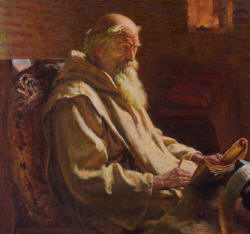
The Ecclesiastical History Of The English Nation -Venerable Bede
CHAP. VIII
HOW EARCONBERT, KING OF KENT, ORDERED THE IDOLS TO BE DESTROYED; AND OF HIS DAUGHTER EARCONGOTA, AND HIS KINSWOMAN ETHELBERGA, VIRGINS CONSECRATED TO GOD
IN the year of our Lord 640, Eadbald, king of Kent, departed this life, and left his kingdom to his son Earconbert, which he most nobly governed twenty-four years and some months. He was the first of the English kings that of his supreme authority commanded the idols, throughout his whole kingdom, to be forsaken and destroyed, and the fast of forty days before Easter to be observed; and that the same might not be neglected, he appointed proper and condign punishments for the offenders. His daughter Earcongota, as became the offspring of such a parent, was a most virtuous virgin, always serving God in a monastery in France, built by a most noble abbess, called Fara, at a place called Brie; for at that time but few monasteries being built in the country of the Angles, many were wont, for the sake of monastical conversation, to repair to the monasteries of the Franks or Gauls; and they also sent their daughters there to be instructed, and delivered to their heavenly bridegroom, especially in the monasteries of Brie, of Chelle, and Andelys. Among whom was also Sethrid, daughter of the wife of Anna, king of the East Angles, above mentioned; and Ethelberga, natural daughter of the same king; both of whom, though strangers, were for their virtue made abbesses of the monastery of Brie. Sexberga, that king’s eldest daughter, wife to Earconbert, king of Kent, had a daughter called Earcongota, of whom we are to speak.
Many wonderful works and miracles of this virgin, dedicated to God, are to this day related by the inhabitants of that place; but it shall suffice us to say something briefly of her passage out of this world to the heavenly kingdom. The day of her departure drawing near, she visited the cells of the infirm servants of Christ, and particularly those that were of a great age, or most noted for probity of life, and humbly recommending herself to their prayers, let them know that her death was at hand, as she knew by revelation, which she said she had received in this manner. She had seen a number of men, all in white, come into the monastery, and being asked by her, “What they wanted, and what they did there?” they answered, “They had been sent thither to carry away with them the gold medal that had been brought thither from Kent. That same night, at the dawn of morning, leaving the darkness of this world, she departed to the light of heaven. Many of the brethren of that monastery that were in other houses, declared they had then plainly heard concerts of angels singing, and the noise as it were of a multitude entering the monastery. Whereupon going out immediately to see what it might be, they saw an extraordinary great light coming down from heaven, which conducted that holy soul, set loose from the bonds of the flesh, to the eternal joys of the celestial country. They add other miracles that were wrought the same night in the same monastery; but as we must proceed to other matters, we leave them to be related by those to whom such things belong. The body of this venerable virgin and bride of Christ was buried in the church of the blessed protomartyr, Stephen. It was thought fit, three days after, to take up the stone that covered the grave, and to raise it higher in the same place, which whilst they were doing, so great a fragrancy of perfume rose from below, that it seemed to all the brothers and sisters there present, as if a store of the richest balsams had been opened.
Her aunt also, Ethelberga above mentioned, preserved the glory so pleasing to God, of perpetual virginity, in great continency of body, but the extent of her virtue became more conspicuous after her death. Whilst she was abbess, she began to build in her monastery a church, in honour of all the apostles, wherein she desired her body might be buried; but when that work was advanced half way, she was prevented by death from finishing it, and buried in the very place of the church where she had desired. After her death, the brothers occupied themselves with other things, and this structure was intermitted for seven years, at the expiration whereof they resolved, by reason of the greatness of the work, wholly to lay aside the building of the church, but to remove the abbess’s bones from thence to some other church that was finished and consecrated; but, on opening her tomb, they found the body as free from decay as it had been from the corruption of carnal concupiscence, and having washed it again and put on it other clothes, they removed the same to the church of St. Stephen, Martyr, whose nativity (or commemoration-day) is celebrated with much magnificence on the 7th of July.
Copyright ©1999-2023 Wildfire Fellowship, Inc all rights reserved

 Keep Site Running
Keep Site Running